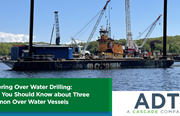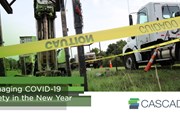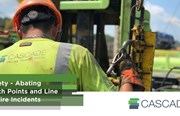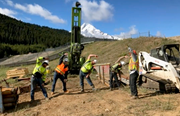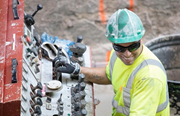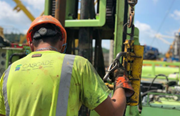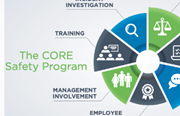- Dale Duscher
Understanding the unique hazards associated with environmental and geotechnical drilling saves lives. Performing the very same tasks in an over-water setting requires an additional level of detail in planning and execution to ensure your job is completed safely, on-time, and on-budget. Thorough preparation is the first and most crucial step in every over the water drilling project. This blog addresses the three common safety concerns: barge configuration, crew safety, and spill protection.
Barge Configuration
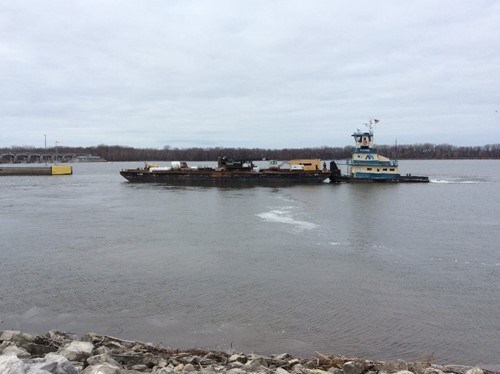
Understanding the type and configuration of the individual barge utilized for your project is essential for adequate safety planning. Tides, waves, and stability are the primary safety concerns out on the water. These basic steps will prepare the crew for dealing with these forces.
ANCHOR THE DRILL RIG TO THE DECK
An unsecured rig poses a serious hazard during travel and operations. The unexpected movement could injure crew members or may even cause the barge to capsize. During operations, the drilling movements alone are capable of moving an unsecured rig across the deck. Rotation torque can cause lighter drills to rotate, and too much feed pressure will raise the back end of the drill off the barge surface, causing it to slide ahead. D-Rings or tie downs secure the rig to the barge decks. In addition to the drill rig, all tooling should be stored in racks and chained to the barge deck before travel.
LOCATE THE “MOON HOLE”
The moon hole is an opening in the deck through which the drilling operations are performed. If it’s too close to the edge, the crew’s safe working area is limited and the barge is much less stable. If the moon hole is close to the edge but the barge is stable, temporary platforms with railings and toeboards can be added to extend the surface of the barge in the crews working area.
ENSURE THE BARGE TYPE CAN HANDLE WATER CONDITIONS
Floating barges are susceptible to waves and raising or lowering tides. Often in high winds, a crew working on a floating barge will need to stop work much sooner, and even in moderate wind, waves can come over the surface of the floating barge. One safety concern with jack up barges is exit & entry. Moving the crew on and off the barge presents an additional safety hazard because the jack up barges are left in the raised position overnight to protect them from tides and waves. Life jackets must be worn at all times. Also, entry and exit points must remain open and free of obstructions.
MITIGATE SLIPPERY SURFACES
The decks of barges are typically metal. When exposed to the inevitable wet conditions, a clear slip hazard arises. This is amplified as the temperatures reach freezing and ice forms on deck. Several precautions can protect crews under these conditions. Squeegees are great for getting water off the deck, and sand can be used in both winter and summer. (Most likely, for environmental concerns, ice melting agents will not be allowed). Good housekeeping also pays off. Bentonite and grout materials on wet metal decks is a recipe for disaster.
CONFIRM ACCESS TO A RESCUE BOAT.
A rescue boat is a must. Just having the tug available is not adequate. A smaller, easier to maneuver rescue boat should accessible at all times.
Now that we’ve figured out what we need for the barge, let’s consider some other factors.
Crew Safety
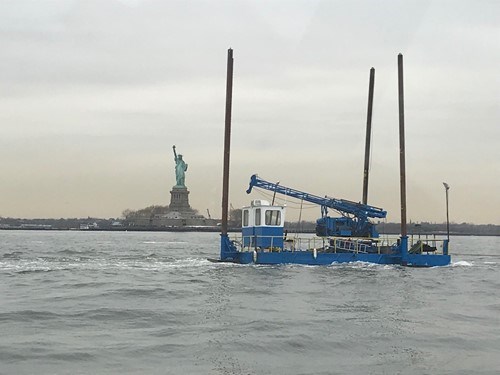
Personal protective equipment (PPE) depends on several factors including wind, temperature, and time of year. Drowning is the main hazard while working over water, so personal flotation devices (PFDs or life jackets) are a PPE requirement. There are several types and styles of PFDs available. First and foremost- PFDs must be adequately sized to the individual crew member. They should be a marine type with sufficient weight rating for the crew member, with consideration given to the extra weight and bulk of any clothing. If working at night, the life jackets and survival suits must be equipped with water activated lights to make them visible in the water.
During cold weather operations, hypothermia is a potential hazard. Severe injury or even death can occur in just a matter of minutes in cold water, therefore, you must be prepared for the situation. Survival suits, commonly called Mustang Suits, protect a person against hypothermic water conditions and are required for cold weather operations. Ensure the barge is equipped with the proper tools and supplies to perform a water extraction should a crew member fall overboard including a way to warm him/her and protect him/her from the elements. The cab of a tugboat is often used for shelter. But in some cases, barges are moved by smaller, open bow boats that will not provide any relief.
WIND IS ANOTHER ISSUE TO CONSIDER
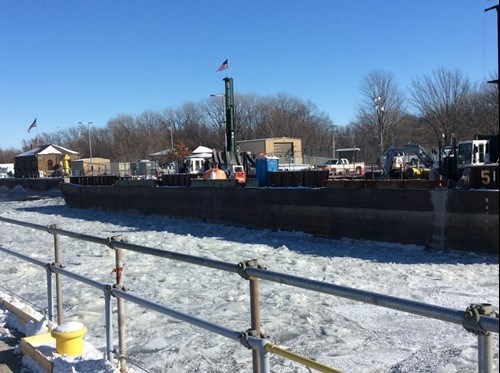
Over the water scenarios often lend themselves to high winds, and a policy must be in place for defining action levels and stop work limits. At wind speeds of 30mph, Cascade crews are required to stop work and assess the situation. Depending on the situation, work may have to be stopped at this point, or controls put into place to help mitigate any hazards caused by high winds, such as extra securement, life lines and a change in the drilling method. At wind speeds of 35mph, a complete stop work is initiated and the crew should seek shelter.
Additional PPE supplies include:
- Extra life jackets. This is a must in case one being worn gets wet or damaged. A minimum of 1 extra for every different size being worn should be on hand.
- Life rings. Station life rings at appropriate areas along the entire length of the barge, and on both sides. Ensure the rope is in good condition. Replace it immediately if it shows any sign of wear.
- Hypothermia suits, blankets, towels, and a change of clothes. If someone may fall into the water, you must consider how you will keep them dry and warm. Keep these in a dry place so they are ready if needed.
- A supply of the usual PPE. Hard hats, safety glasses and gloves have all been blown into the water by winds. Leaving the barge to get a replacement hard hat is not the most practical thing and having spares of these items is a good idea.
- A good plan for evacuation. Although rare, there are several scenarios in which a crew may need to evacuate the barge. It could be a fire, severe weather or even a sinking barge, if the need to evacuate should arise, you must have a plan and you must be prepared.
- Training. The crew must be trained for the unique hazards that working over water presents, and more experienced operators and assistants should be selected for these jobs. In the event of an emergency, the logistics of reaching the crew creates a lag time in first responder assistance. The crew must be CPR and First Aid trained and have the confidence to use it.
Spill Protection
Oil, fuel, or drilling fluids spilled into the water can become a significant environmental incident resulting in substantial financial and ecological damage. All containers carrying any environmentally sensitive materials must be kept in secondary containment. This includes all welders, compressors, light plants, and generators. Placing a minimum 6 mil poly sheathing beneath the rig with the sides of the sheeting raised is the first line of defense in spill protection. The containment capacity should exceed the volume of oil the drill holds. Extra oil absorbent diapers, socks, booms, and plastic bags for holding oil-soaked material should be placed in a readily accessible location, along with a couple of empty drums for holding large amounts of recovered oil.
ADDITIONAL RESOURCES
This is just a brief mention of some of the unique hazards that working over water presents. There are many other hazards that must be taken into consideration for a successful, injury free over the water job.
In all cases, a thorough Site-Specific Health and Safety Plan must be made to address these issues, and the crews must be familiar with its contents. Planning and preparation, along with experience, will make the difference.
You can take a deeper dive into the nuances of over water drilling by accessing our webinar here, or download this project highlight, which breaks down an over water drilling investigation Cascade conducted in San Francisco. Learn more about Cascade’s world-class safety program, CORE ™, on our website here.
Categories
- Site Remediation
- Drilling
- Careers
- Cascade Chemistries
- Safety
- Site Characterization
- Thermal
- Rotary
- Sustainability
- In Situ Stabilizaton
- High Resolution Site Characterization
- Injection
- Sonic Drilling
- Automated injection
- corporate sustainability
- case studies
- in situ thermal remediation
- Cascade Drilling
- Over Water Drilling
- In Situ Stabilization (ISS)
- ISS
- Environmental Remediation
